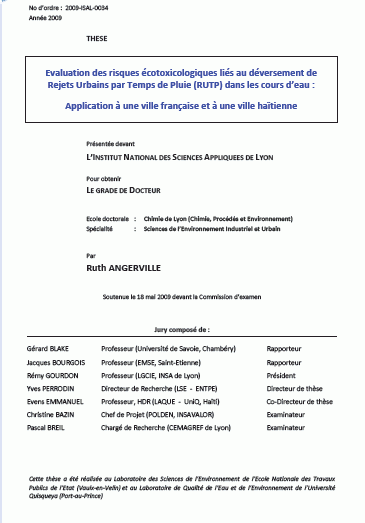Evaluation des risques écotoxicologiques liés au déversement de rejets urbains par temps de pluie (RUTP) dans les cours d'eau: Application à une ville française et à une ville haïtienne
 |
thèse May 2009 ; 485 pages
Aut. Ruth Angerville
Ed. ENTPE - Vaulx en Velin
Téléchargeable sous format: PdF
Téléchargeable chez l'éditeur
Résumé:
Les Rejets Urbains par Temps de Pluie (RUTP) contiennent des polluants sous forme soluble ou particulaires, issus du lessivage des bassins-versants qu'ils drainent. Ces rejets sont le plus souvent déversés dans les milieux récepteurs, en particulier les cours d'eau péri-urbains, sans traitement préalable. Il en résulte, dans certaines configurations, un risque de toxicité pour les écosystèmes des milieux concernés. Cette thèse propose deux démarches méthodologiques pour évaluer les risques écotoxicologiques (EDREcotox) liés à un tel scénario: une démarche a priori et une démarche a posteriori.
La démarche a priori a été développée selon 3 approches complémentaires de caractérisation des effets écotoxicologiques: i) une «approche substances», ii) une «approche substances avec effets combinés» et iii) une «approche matrice». Cette démarche a priori a été par la suite appliquée à un scénario d'une ville française et à un scénario d'une ville haïtienne. Pour une optimisation de la méthodologie proposée dans le cadre de la démarche a priori, nous avons procédé, dans un premier temps, à une étude de l'écotoxicité et des effets combinés des principaux polluants généralement présents dans les RUTP, vis-à-vis de Daphnia magna puis de Pseudokirchneriella subcapitata. En ce qui concerne l'«approche matrice», nous avons procédé à une caractérisation écotoxicologique d'échantillons de RUTP provenant des 2 sites étudiés. La démarche a posteriori a été développée sur la base d'une comparaison entre un «état amont» et un «état aval», par rapport au point de déversement des RUTP dans la rivière du site français, pour 3 horizons (eau de surface, zone benthique et zone hyporhéique).
L'application de ces 2 démarches méthodologiques a conduit à des résultats cohérents qui mettent en évidence un risque important pour les organismes du cours d'eau récepteur, avec une accentuation de ce risque pour les organismes des zones benthique et hyporhéique. Au titre des perspectives, la poursuite du développement de ces premières méthodologies pourra prendre en compte certains aspects additionnels comme la biodisponibilité des polluants, leur bioaccumulation, etc. Abstract:
The Urban Wet Weather Effluents (UWWE) contain pollutants in dissolved or particulate form, resulting from the wash-off of the associated watershed. These effluents are generally discharged in the receiving waters, particularly in the periurban watercourses, without preliminary treatment. In some cases, this situation results in observing, in some cases, a risk of toxicity for the ecosystem of the related mediums.
This study proposes 2 methodological frameworks to assess the ecotoxicological risks (EDREcotox) related to this specific scenario: an a priori framework and an a posteriori framework. The a priori framework was developed according to 3 complementary approaches to characterize the ecotoxicological effects: i) a “substances approach”; ii) a “substances with combined effects approach”; iii) “a whole-effluent approach”. This a priori framework was applied thereafter to a scenario of a French city and to a scenario of an Haitian city. In order to optimize the a priori framework, we realized firstly a study of the ecotoxicity and of the combined effects of the main pollutants found in UWWE on Daphnia magna and then on Pseudokirchneriella subcapitata. With regard to the “whole-effluent approach”, we carried out an ecotoxicological characterization of UWWE samples coming from the 2 studied sites. The a posteriori framework was based on the comparison between an “upstream state” and a “downstream state”, both compared to the UWWE discharge point in the stream of the French site, for 3 compartments (surface water, benthic zone and hyporheic zone) of this stream.
The application of these 2 methodological frameworks led to coherent results which highlight an important risk for the organisms of the receiving stream, with an emphasizing of this risk for the organisms of the benthic and hyporheic zone. For further developments, we propose to optimize these methodologies by taking into account additonnal aspects such as bioavailability, bioaccumulation, … of these pollutants.
Public-Cible:
Mots clefs: |
eaux pluviales (gestion) (CI) (DT) (OP) (ope) , maladie (CI) (DT) (OP) (ope) , pollution (CI) (DT) (OP) (ope) , pollution de l'eau (CI) (DT) (OP) (ope) |
Pays concernés: |
Editeur/Diffuseur: |
|
ENTPE
-
Ecole nationale des travaux publics de l'Etat - Vaulx en Velin |
En cas de lien brisé, nous le mentionner à communication@pseau.org